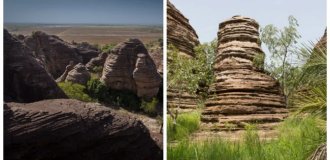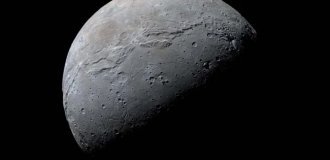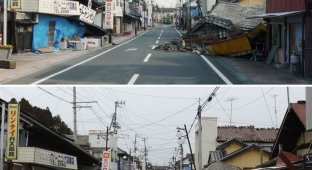Baikonur: “Energy” and “Buran” (20 photos)

The last flight of the shuttle Atlantis, pictures of the landing of which, as usual in such cases, caused a discussion in the comments to the post, forced, nevertheless, using the free time that appeared, to open the archived folder of photographs of the trip in the KIA Mohave in Kazakhstan and show what I saw at the Baikonur Cosmodrome, in addition to the launch of the Soyuz TMA-16 spacecraft.
The day after the G7 launched, we went to see what was left of the Energia-Buran project, the Soviet response to the American shuttles. From the observation deck where we watched the launch of the R-7, the cyclopean structures of the launch pads from where the Buranas were supposed to fly into space were clearly visible.
In the photo above is the same ill-fated assembly and testing building (MIC) at the 112th site of the cosmodrome, where on May 12, 2002 the roof collapsed, burying eight people, the Energia launch vehicle and the only copy of the Buran that flew into space. . Here and now everything remains the same, only the Buran is no longer inside - it, as the cosmodrome workers say, was cut into pieces and sold as scrap metal. No one is going to fix the roof - no one needs the building anymore. By the way, it is adjacent to the operating assembly shop of NPO Energia, where the “sevens” are assembled.

At the gates of the destroyed MIK, eternal monuments of the era stand two gigantic transport and installation units (TUA), on which, according to the project, the launch vehicle and the shuttle were supposed to be delivered to the launch site. The weight of each unit is 2,750 tons; they moved on special rails using several unique diesel locomotives of the ZMU62P series. Someday, thousands of years from now, archaeologists will find these monsters in the desert and will puzzle over why people needed them in the 20th century.

Nature is already taking its toll; the area in front of the MIK is slowly becoming overgrown with grass, which breaks through the cracks in the concrete slabs.

On the left is the gate of the destroyed MIK. The unit (TUA) drove there, “Energia” with “Buran” on its back was loaded onto it using a crane and then transported to the launch complex. There are two units - it was planned that Buran launches would occur almost every month, or even more often.

Now this place is fenced with rusty barbed wire. The units were chosen by a family of stray dogs. They feed nearby - in the canteen of NPO Energia.

View in the opposite direction from the MIK - the Energia with the Buran was leaving there on rails for the launch pad. The white tower on the left is a vibration test stand for connecting the launch vehicle with the shuttle.

It’s a long drive from MIK to the launch complexes; the distances here are long. The road runs along the railway track along which the Energia-Buran complex moved.

The launch complex from where Buran took off on its first and only flight. There is no one there now, the complex is mothballed and guarded by the cosmodrome security service. They try to protect everything that has not yet been stolen. The territory of the cosmodrome is huge and previously, from the side of the steppe, the local population periodically raided it in the hope of profiting from something useful on the farm that could be sold for scrap metal.

Nearby stands the twin brother of the Energia-Buran launch complex. It is completely abandoned and appears to be unfinished. There were supposed to be four such sites in total, but the last, fourth, had just begun to be built when the program was closed. The Buran launch sites are clearly identified by the pipes of the emergency cosmonaut evacuation unit (AEE). It consists of an inclined elevator for loading/unloading crew and a chute for emergency evacuation.

"Buran" flew from here.

General view of two launch complexes for Buran.

We were going to the site of the first launch of Energia, to site 250a. This concrete panel depicts the launching "Energia" with a model of the combat laser space platform "Polyus" on its back. The Polyus was never launched into the intended orbit and was sunk in the Pacific Ocean.

Along the road were the remains of a gallery with communications and pipelines for the launch complex. The entire Energia-Buran program was intended for military purposes, the military worked here, hence the slogans on the walls of the gallery, like this or this

General view of the Energia launch complex at site 250a. Here, on May 15, 1987, the first launch of a new launch vehicle took place.

No photograph can convey, of course, how gigantic this launch complex is, overwhelming in its size. The height of this service tower is more than 100 meters. The lightning rod masts are nearby - much higher.

There's really not enough human figure here for scale, but you can navigate by the width of a regular railway track you know - here they are, one and two. “Energia” was brought to the start along this road from MIK, which is not even visible from here. On the left in the distance you can see the Buran launch pads.

The gas outlet tray is also striking in its size - it is several times larger than that of the Gagarin launch pad, from where the Soyuz rockets fly into space.

Starting table "Energy". Iron structures with “steps” are lighters for the launch vehicle engines. The nozzles of water cannons are visible - before the launch of the rocket, water was accumulated at Baikonur for several weeks; for such a launch, several thousand tons are needed.

Top view of the starting table. Round metal blanks (where the torn fabric is) are supports for the launch vehicle. “Seven” at the launch site hangs on special hooks, like a coat on a hanger - for “Energia” they came up with a different system; after the service trusses were removed, the rocket remained standing on these round stands.

Another giant piece of iron is a movable service tower.
Types of the Energia launch complex:






During construction, the entire site of the complex was lined with the following metal tiles:


During the first launch of Energia, the rocket tilted slightly and a stream of hot gases blew away the entire coating in an instant. Traces from flying metal tiles are still visible on the iron bases.

The launch complex at site 250a is mothballed. Chemical production facilities built nearby are used to produce rocket fuel components.

In the courtyard of the museum at the cosmodrome there is one of the test mock-ups of the Buran.
Inside the shuttle cabin:




As a summary: it is difficult for me to imagine how much money was invested and, as a result, wasted for the development and construction of the Energia-Buran project. Those who have been reading this diary for a long time know my partial attitude towards cosmonautics in general and the Soviet one in particular. For me, this is a very interesting topic - literally everything related to the conquest of space. However, now I cannot help but understand that astronautics, especially manned space exploration, is the privilege of developed countries. Countries where everything is already fine.
To get involved in a story that costs billions and billions, for a country in which there is no developed infrastructure, in which there are no roads, where half of the population lives, to put it mildly, in cramped material and housing conditions, where there is no normal medicine and God knows what else is missing - it’s simply it is forbidden. The prestige of the country, since it is so necessary to conquer, does not consist of such space games, but precisely from those very good roads, a well-fed, prosperous and healthy population, a low level of corruption, and a sane government system.
Now, when all this is in the country, then, please, you can spend money on space, launch beautiful winged cars to the stars and be proud of it. The USSR had none of this, so spending billions of rubles on such monstrous projects was pointless and inhumane - let’s call a spade a spade.






















